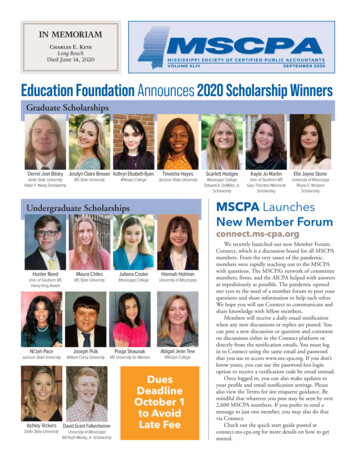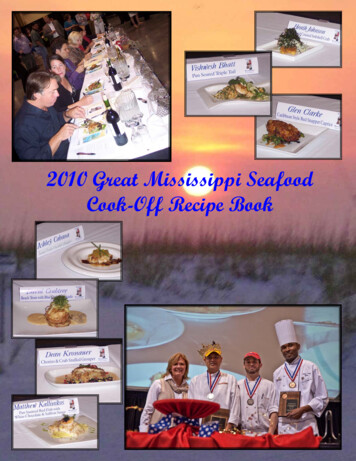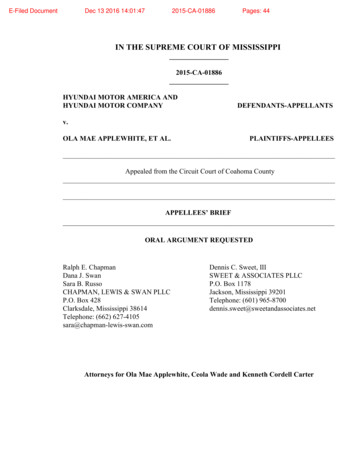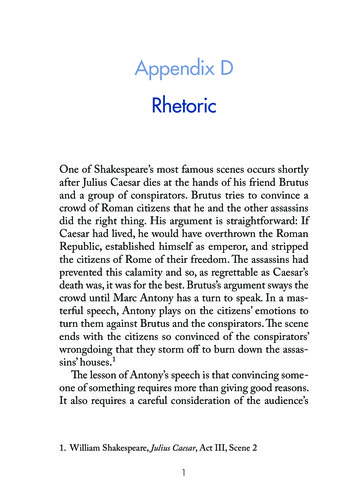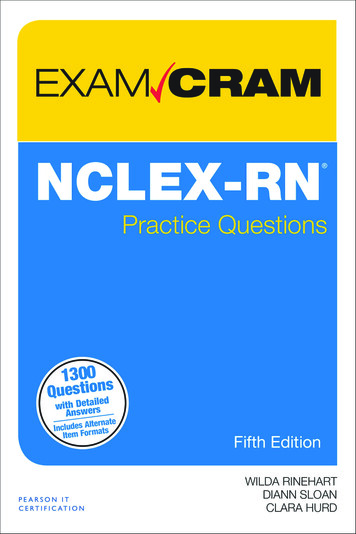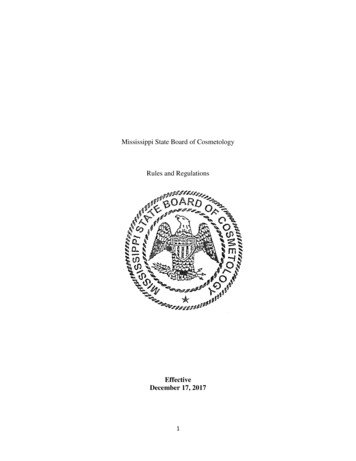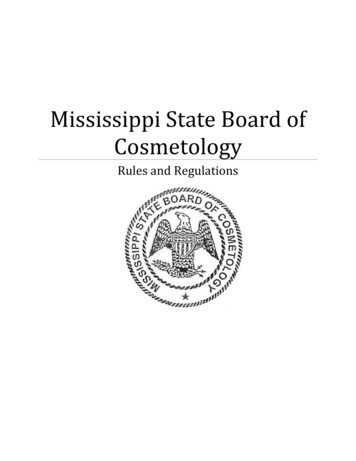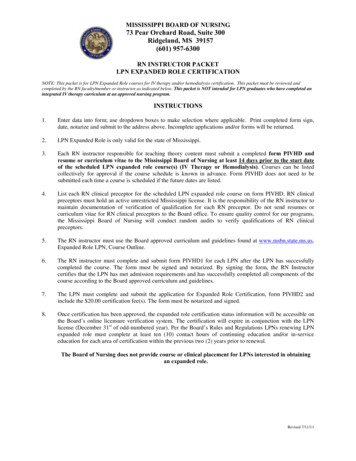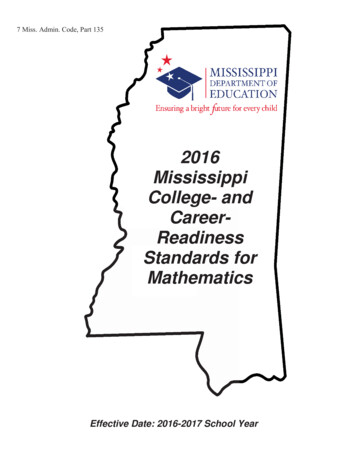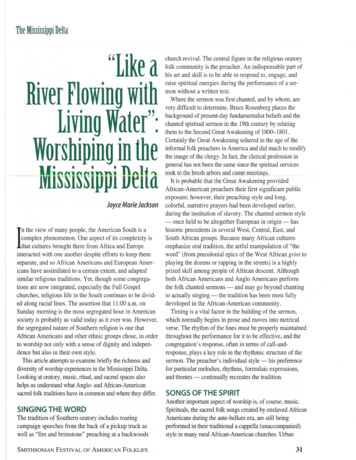
Transcription
The Mississippi Delta"Like aRiver Flowing withLiving Water":Worshiping in thelVll ·s . ppi vrltaJoyce Marie Jacksonn the view of many people, the American South is acomplex phenomenon. One aspect of its complexity isthat cultures brought there from Africa and Europeinteracted with one another despite efforts to keep themseparate, and so African Americans and European Americans have assimilated to a certain extent, and adaptedsimilar religious traditions. Yet, though some congregations are now integrated, especially the Full Gospelchurches, religious life in the South continues to be divided along racial lines. The assertion that 11:00 a.m. onSunday morning is the most segregated hour in Americansociety is probably as valid today as it ever was. However,the segregated nature of Southern religion is one thatAfrican Americans and other ethnic groups chose, in orderto worship not only with a sense of dignity and independence but also in their own style.This article attempts to examine briefly the richness anddiversity of worship experiences in the Mississippi Delta.Looking at oratory, music, ritual, and sacred spaces alsohelps us understand what Anglo- and African-Americansacred folk traditions have in common and where they differ.ISINGING THE WORDThe tradition of Southern oratory includes roaringcampaign speeches from the back of a pickup truck aswell as "fire and brimstone" preaching at a backwoodsSMITHSONIAN FESTIVAL OF AMERICAN FOLKLIFEchurch revival. The central figure in the religious oratoryfolk community is the preacher. An indispensable part ofhis art and skill is to be able to respond to, engage, andraise spiritual energies during the performance of a sermon without a written text.Where the sermon was first chanted, and by whom, arevery difficult to determine. Bruce Rosenberg places thebackground of present-day fundamentalist beliefs and thechanted spiritual sermon in the 19th century by relatingthem to the Second Great Awakening of 1800-1801.Certainly the Great Awakening ushered in the age of theinformal folk preachers in America and did much to modifythe image of the clergy. In fact, the clerical profession ingeneral has not been the same since the spiritual servicestook to the brush arbors and camp meetings.It is probable that the Great Awakening providedAfrican-American preachers their first significant publicexposure; however, their preaching style and long,colorful, narrative prayers had been developed earlier,during the institution of slavery. The chanted sermon style- once held to be altogether European in origin - hashistoric precedents in several West, Central, East, andSouth African groups. Because many African culturesemphasize oral tradition, the artful manipulation of "theword" (from precolonial epics of the West African griot toplaying the dozens or rapping in the streets) is a highlyprized skill among people of African descent. Althoughboth African Americans and Anglo Americans performthe folk chanted sermons - and may go beyond chantingto actually singing -the tradition has been most fullydeveloped in the African-American community.Timing is a vital factor in the building of the sermon,which normally begins in prose and moves into metricalverse. The rhythm of the lines must be properly maintainedthroughout the performance for it to be effective, and thecongregation's response, often in terms of can-andresponse, plays a key role in the rhythmic structure of thesermon. The preacher's individual style- his preferencefor particular melodies, rhythms, formulaic expressions,and themes - continually recreates the tradition.SONGS OF THE SPIRITAnother important aspect of worship is, of course, music.Spirituals, the sacred folk songs created by enslaved AfricanAmericans during the ante-bellum era, are still beingperformed in their traditional a cappella (unaccompanied)style in many rural African-American churches. Urban31
The Mississippi Deltachurches have added piano accompanimentas well as other forms of instrumentation,and spirituals have also been arranged asgospel songs.Although Anglo- and African-AmericanBaptists in the Delta rarely share theirpews, they do share some of their hymns.Common to both churches is the lining-outstyle of the Dr. Watts and other long-meterhymns. (Dr. Isaac Watts was an 18thcentury English Methodist hymn writer.)Lining-out is a hymn-singing tradition thatarose out of necessity. There was a lack ofhymn books and an abundance of peoplewho could not read; therefore, one personwas designated to "pitch" the song for thewhole congregation. Both African andAnglo Americans practice this tradition indifferent performance styles. In the Anglotradition the congregation sings almost the exact melodyand rhythms of the leader, with some variation fromindividual singers; in the African-American tradition, thelead voice and congregation overlap melodically andrhythmically and decorate the hymn tunes with variousvocal embellishments and moans. This produces an extraordinary effect sometimes called surge singing. In manychurches this style is still performed a cappella.Another style of religious music still prevalent today inthe Delta is sacred harp, in which a system of four shapes- a triangle, circle, square, and diamond - is employedto designate the musical syllables fa, sol, la, and mi(shape-note singing is also called fasola singing). Thissystem, a popular and effective way of teaching people to"read" music, was an outgrowth of the New Englandsinging school movement and the Great Awakening.Published in Philadelphia in 1801, William Little's TheEasy Instructor, or A New Method of Teaching SacredHarmony introduced the shape-note system to the generalpublic. Later in the 19th century the publication of booksemploying the shape-note system began to spread south.William Walder's Southern Harmony (1835) and Benjamin White and B.J. King's The Sacred Harp (1844)have been two of the most widely used.The Anglo-American sacred harp singing conventionsthat take place in the Delta are usually all-day affairs, andeverybody is expected to participate in these religioussocial events. What follows the singing is another tradition- "dinner-on-the-grounds," Congregation outside Bethlehema communal feast contribNo. 2Missionary Baptist Church,uted to by all participants.Shaw, Mississippi.Most of the singing is stillPhoto Tom Rankindone a cappella with thehymns sung first using the"fasola" syllables.Although shape-note singing has been called Whitespiritual and White gospel singing, the system was adaptedby certain African-American congregations in the Southduring the 1880s using texts of songs drawn from oldhymns, gospel songs, and a few spirituals. There is only onecollection of African-American sacred harp compositions,The Colored Sacred Harp (1934) by Judge Jackson.The African American Shape Note and Vocal MusicSinging Convention Directory for Mississippi and Areasof Northeast Alabama was published through the effortsand coordination of Chiquita Willis to "foster and supporta network of African-American shape-note music singersand supporters that will facilitate interaction among conventions." In August 1993, nearly 300 people, includingdelegations from twenty different singing conventions,attended the two-day West Harmony Singing Conventionheld at Pleasant Grove First Baptist Church in GrenadaCounty, Mississippi. This convention and the work ofChiquita Willis have demonstrated that Mississippi has amuch larger, more widespread shape-note tradition thanpreviously thought.32SMITHSONIAN FESTIVAL OF AMERICAN FOLKLIFE
The Mississippi DeltaRev. Lionel/ Wilson leads the"rocking" procession and carries thebanner which symbolizes the cross.The table is ornamented with twelvelamps representing the twelvedisciples and twelve cakesrepresenting the twelve tribes ofIsrael. This sacred ritual takes placein the Winnsboro community in theLouisiana Delta region.Photo J. Nash PorterMembers of ashape-note singingconvention perform at Union ChapelBaptist Church in Monroe, Louisiana.Shape-note singing is asystem ofnotated music commonly using four orseven shapes in lieu of the round notesfound in standard European notation.This singing school system facilitateslearning the music by note.Photo J. Nash PorterAmong the various African-American shape-note singinggroups in the Louisiana Delta area are the Winnsboro SeniorCitizen Singers and Mr. and Mrs. Orland Johnson, a singingcouple from Start, Louisiana. They participate along withother groups, most of whom sing a cappella, in the parishwide, state, and regional convention and singing schools.The shape-note singing conventions also led to the formation of some a cappella gospel quartets. The OldhamFamily from West Carroll Parish in Louisiana is an English/Scots/Irish quartet that sings hymns learned in shapenote singing schools with the newer seven-note shape-notesystem.A number of African-American quartets in the Deltastarted with the shape-note system as well. The PleasantStar Singers (formed in 1946), one of the oldest a cappellaquartets in the Winnsboro, Louisiana, area, still sing withthe singing conventions. The Convention Specials Quartet(with members from various Delta parishes), the MightySoul Guides, and the Royal Newtown Spiritual Quartetfrom Monroe can usually be found at church programs andquartet anniversaries.SMITHSONIAN FESTIVAL OF AMERICAN FOLKLIFEGospel music has contributed tremendously to theMississippi Delta region's unique musical heritage. Thisnew sacred music of the 20th century reflects the concernsof urban life and to a large extent has replaced othersacred styles like the folk spiritual and the Dr. Wattshymn. In the African-American community during the1920s the gospel tradition began to emerge in small,urban, Pentecostal "storefront" churches, then gradually inBaptist churches. Now the genre has found its way intothe sanctuaries of African-American congregations ofvirtually every religious denomination, including Catholic.When Anglo-American settlers moved into the Delta,they brought with them their fiddling, ballad-singing, andsacred music traditions. Their gospel music can be foundin performances of gospel quartets, family and communitygroups, and country and bluegrass bands. Many of thesestyles are rooted in the shape-note singing tradition.Though country and bluegrass music differ in theirthemes and instruments, bands from both genres usuallyperform sacred songs. You can also find an occasionalsacred instrumental band in the Delta. Rev. Gerald Lewis,33
The Mississippi Deltawho grew up in Ferriday, Louisiana, plays gospel piano inhis Pentecostal Band and built a ministry in several ruralchurches in Swartz,Cited BrLouisiana. His cousins JerrySuggested ReadingLee Lewis, Mickey Gilley,and Jimmy Swaggart tookThe African American Shape Note &Vocal Musicthat small-town backgroundSinging Convention Directory: Mississippi andand musical skill to the topAreas of Northwest Alabama. 1994. Mississippiof the rock and roll,Folklife 27.country, and televisionDavis, Gerald l. 1985.1 Got the Word in Me and I Conevangelism fields.Sing It, You Know: AStudy of the PerformedorksAfrican-American Sermon. Philadelphia:University of Pennsylvania Press.Ellington, Charles linwood. 1969. The Sacred HarpTradition of the South: Its Origin and Evolution.Tallahassee: Florida State University.Jackson, Joyce Marie. 1995. The Changing Nature ofGospel Music: ASouthern Case Study. TheAfrican American Review 29 (2):185-200. 1981. The Black American Folk Preacher andthe Chanted Sermon: Parallels of aWest AfricanTradition. In Discourse in Ethnomusicology II: ATribute to Alan P. Merriam, ed. Caroline Cardet al. Bloomington: EthnomusicologyPublication Group.Jackson, Judge. 1992. The Colored Sacred Harp, ForSinging Closs, Singing School, Convention andGeneral Use in Christian Work and Worship.Montgomery, Alabama: Brown Printing.Olsen, Ted. 1991 and 1992. The Voices of the OlderOnes: The Sacred Harp Singing Tradition inCalhoun County, Mississippi. Mississippi FolkloreRegister 25 and 26.Rankin, Tom. 1993. Sacred Space: Photographs fromthe Mississippi Delta. Jackson: University Press ofMississippi.Rosenberg, Bruce A. 1988. Con These Bones Live?: TheArt of the American Folk Preacher. Urbana:University of Illinois Press.Staten, Annie, and Susan Roach. 1996. Take Me to theWater: African American River Baptism. In TheLouisiana Folklife Festival Program Book. Monroe:Louisiana Folklife Festival.Sturman, Janet. 1993. Asserting Tradition: Buildingand Maintenance of African-American BaptistRock Ceremony in Northeast Louisiana.Louisiana Folklife 27:24-32.34SACRED RITUALSRites of passage such asbirth, death, and marriagemark a change in a person'ssocioreligious position.Baptism in the Delta region,a symbolic ritual of purification and initiation, is asignificant rite of passage.As late as the 1950s, riversubmersion was common inboth African- and AngloAmerican Protestantchurches but continuestoday primarily amongAfrican Americans.Nowadays, after theirweek-long annual revival,Rev. L.D. Oliver, pastor ofSt. Paul Baptist Church inMonroe, Louisiana, andRev. Roosevelt Wright, Jr.,pastor of the TabernacleBaptist Church, gather theircongregations together forthe river baptism. In thissetting the old, traditionalspirituals such as "Take Meto the River," "I Know I'veGot Religion," and "Wadein the Water" are sung. Rev.Oliver works to remindother area ministers andyouth about their heritage ofriver baptism from thebiblical example set by John the Baptist baptizing Christin the Jordan River.Rituals involving immersion in bodies of water are alsoprevalent in traditional African religious ceremonies. Theyare symbolic of purification, washing away evil and healingthe physical as well as the spiritual being. The ritual act ofimmersion carries the hope of renewal and freedom, ideasthat have driven African-American spirituality.The ministers in Rayville and Alto still take theircongregations to the nearby Beouf River, and in Monroe theOuachita River at the Foot of Pine Street has been used forseveral generations. This sacred place is called by the eldersof the community the Old Burying Ground, an appropriatename for the place of ritual baptism in which "the candidateis symbolically buried in Christ, sins are washed away, andone is raised up to walk in newness of life."Another sacred ritual that takes place in rural AfricanAmerican Baptist churches in northern Louisiana is theEaster Rock ceremony held on the eve of Easter Sunday.In this ritual the elders sing some of the old traditionalspirituals such as "Oh, When the Saints Go Marching In"and "King David." The songs are sung in a chant-likemanner, as the participants move counterclockwise withcircular rocking movements around a table placed in themiddle of the church floor. Dr. Watts and other long-meterhymns such as "I Know the Lord Will Answer Prayer"and "I Love the Lord, He Heard My Cry" are also veryprominent in the context of the Easter Rock. The congregants dress in white, and the leader carries a circular banner representing the cross. The table is decorated withwhite tablecloths, and twelve lamps and twelve cakes,representing the twelve disciples and twelve tribes ofIsrael. The Easter eggs on the table symbolize new birth.This ritual clearly has African and Caribbean antecedents; there are many accounts of sacred circular dancesthroughout the African Diaspora. Some of the elderlyDelta participants recalled their parents remembering thetradition as pre-dating the Civil War. The "rock" hadvanished for awhile, then certain individuals becameinterested in the history and began to revive the tradition.The ritual has been passed on by the Addison family formany generations. Now Hattie Addison coordinates theWinnsboro Easter Rock, and people from various congregations in the area participate. The Original True LightBaptist Church, pastored by Rev. J.L. McDowell, is idealfor the "rock" because its wooden floors contribute to thepercussive effect, and movable pews make room to "rock"SMITHSONIAN FESTIVAL OF AMERICAN FOLKLIFE
The Mississippi Deltain a circle. The whole ceremony is done a cappella; onlyhand clapping and foot stamping accompany the songs.Easter Rocks were once held around Ferriday, Louisiana,in Clayton and Sicily Island; however, those have not beenorganized in the last few years.The Oldham Family quartet is asacred English/Scots/Irish group based in theFirst Church of God in Oak Grove, Louisiana. The group sings hymns learned insinging school with the seven-note shape-note system. Photo Susan Roachtional worship traditions is to relive that past and to makeit a source of power for the future of the Delta.SPIRITUAL SPACESThe religious experiences of many people are tied tospecific places where rituals are performed. Some peoplealso construct personal sacred space to their ownspecifications.On Old U.S. 61 in Kings, Mississippi, just outside ofVicksburg, one man's sacred space has been under construction for several years. Rev. Herman Dennis is spreading the word of God not only through his spontaneoussermons but also through his craftsmanship.Dennis has decorated Margaret's Grocery Store (belonging to his wife) in red and white brick with large brickcolumns of varying size. All bear bits and pieces of biblicalphrases and messages that travelers can read. He has alsoplaced reproductions of various symbolic designs in verystrategic places. For example, on the wall, ceiling, and thesidewalk he has placed the Masonic order symbol of the"G," which to him represents God.To the right of the grocery store is a large brick towerwhere he plans to house the Ark of the Covenant, whichwill eventually contain the Ten Commandments. Then, hebelieves, Margaret's Grocery Store will attract people ofall Christian faiths to worship. Dennis believes that God,like himself, is a builder or a "craftsman." "The Almightyis the greatest architect," he says, "and I am his assistant."These genres of worship in the Delta constantly reunitea region by reminding it of its shared but multifocal heritage. Worship traditions are shaped by a collective andselective memory. Decisions are made by regardingfundamental and shared values. To participate in t adiSMITHSONIAN FESTIVAL OF AMERICAN FOLKLIFEJoyce Marie Jackson, an ethnomusicologist andfolklorist, is Associate Professor in the Department ofGeography and Anthropology at Louisiana StateUniversity in Baton Rouge. She received her Ph.D. fromIndiana University, Bloomington. She has been aRockefeller Fellow and has produced The Gospel Train:Zion Travelers Spiritual Singers, a documentaryrecording on the a cappellaquartet tradition. Her book,From These Roots, whichThe Five Blind Boys of Mississippi. The Best ofthe Fivealso focuses on the aBlind Boys. MCA 28022.cappella quartet tradition,is forthcoming.-- ·Precious Memories: ATribute to ArchieBrownlee. MCA 28002.The Hawkins Family. Oo-wee Lord, You Have Been Good.LILSIL's Music, Dallas, Texas.Hemphills. Home Cookin'. Heart Warming.Hunter Brothers. 1995. The Ship. DDS.lewis, Jerry lee.ln Loving Memories: The Jerry Lee LewisGospel Album. Mercury SR61318.Mississippi Sacred Harp Singing. Southern Folklore 101.The Pilgrim Jubilees. The Old Ship oflion. MCA 28010.Racy Brothers. 1996. Time Out. Ace.Smith, Mother Willie Mae Ford. Mother Willie Mae FordSmith. Spirit Feel1010.The Southern Harmoneers. He'll Make a Way. HotProductions, Inc. HTCD 3701-2.Swaggart, Rev. Jimmy. The Golden Gospel Piano. Jim R3607.Tharpe, Sister Rosetta. Gospel Train. MCA 1317.35
"Like a River Flowing with Living Water": Worshiping in the lVll ·s . ppi vrlta Joyce Marie Jackson In the view of many people, the American South is a complex phenomenon. One aspect of its complexity is that cultures brought there from Africa and Europe interacted with one another despite efforts to keep them


